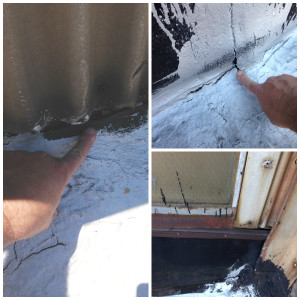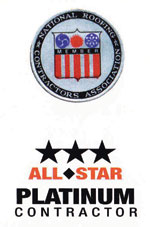Prevent Further Damage to your Roof by Detecting Leaks Early

See images displaying different roofs with leaks
Having a leak in your roof go undetected for an extended period of time can cause a lot of damage. Thankfully, there are many different methods of detecting roof leaks early, which can save you a lot of stress and money. Of course, there is natural detection, which is when the roofing crew walks the roof and searches for any weak spots, which indicate a leak or other damages. However, with advances in technology come many advances in roof leak detection.
There are multiple new technological ways to detect leaking in your roof, which provide more effective and accurate ways to prevent the buildup of damage in your roof. The first method is known as Mechanical Infrared Imaging. To understand what this is, we must first discuss thermography. The study of thermography is the use of thermographs, which is an instrument that can be used to produce an image (sometimes a graph, hence the name) that represents the varying temperature or infrared radiation in an area during an extended period of time. In terms of roof leak detection, thermography is used to produce an image of wet areas on a roof by detecting heat or radiation to determine areas where a roof is leaking. To do this, infrared imaging uses a camera to “see” and “measure” the thermal energy that an object emits. You may be wondering how water or ice could emit thermal energy, because, as you learned in high school chemistry, thermal energy is heat energy. However, although thermal energy is energy in the form of heat, all objects emit thermal energy just in lower or higher concentrations depending on the temperature of said object. So, the higher the objects temperature means the more radiation emitted.
Another method of roof leak detection is EFVM® or Electric Field Vector Mapping. EFVM® is a leak detection method that was invented by ILD® or International Leak Detection, a company that specializes in detecting roof leaks. EFVM® is a method of leak detection that produces low-voltage electric potential between a non-conductive membrane surface and a grounded conductive substrate (underlying layer). First, water is applied to the surface membrane, which acts as a conductive medium to create an electrical field. Then, an electrical charge is created by the electrical field. If there is no leak, the potential difference will be isolated or in other words, the electrical charge will die but if there is a leak a connection will be made between the charges.
Helium provides a lot of people with a lot of fun, whether it is using it to blow up balloons or to make their voice sound funny. However, helium can also be very helpful in detecting leaks in your roof. Helium Injection is a method used to confirm a leak. First, if it is assumed that there is a leak, a line will be traced and technicians must listen to the pipes with the water running. Then, air or inert gases are used to pinpoint where the leak is. Then, helium can be inserted into the line to confirm that a leak is there. This is done using a helium detector, which reads in parts per million to make the reading as accurate as possible.
Conductive Tape is similar to EFVM®, in the fact that it relies on conductive surfaces to detect a leak. Conductive tape is a method of leak detection that uses a grid of conductors that is placed on top of a roof membrane. This method is used both to detect and localize leaks because it will only pick up leaks within the area of the grid. Conductive tape is especially effective for green roofs that have incorporated a waterproofing membrane. This method provides accuracy without breaking the bank and is effective in detecting leaks within a wide range of roof types and sizes.
Another method used for the detection of roof leaks is Water Leak Detectors. Water Leak Detectors work by using microphones and leak noise correlators to listen to two different points on a pipe and comparing the two noises. A computer then inputs diameter, length and type of pipe into the system. A correlation is then made between the leak noise and an exact location of the leak between the two points is made. This method is effective on larger pipe systems and municipal work. Its accuracy comes from the fact that it listens directly on the pipe and can “hear” the leak more clearly.
Smoke to most is an indicator of danger or that something is wrong. However, using the Smoke Testing System is an effective way to pinpoint the exact location of a leak. The Smoke Testing System uses visual indicators to detect leaks. It indicates when there is leaking vapor in sewer and plumbing systems. It works by forcing safe and clean non-toxic liquid smoke into pipes. Leaks can be detected when smoke is seen escaping the pipes in areas where they are weak or damaged.
The last method that we will discuss today that is used to detect leaks is the Video Inspection System. Using a Video Inspection System, a flexible camera is inserted into a pipe, which then relays the image back to the monitor and is recorded to a DVD.
These are just a few of the plethora of different leak detection methods. Using one of these many different methods can save you a lot of heartache. The longer a leak persists, the more damage it causes and the more money it will cost to repair. However, if you use one of these methods to detect a leak in your roof early, you can prevent a leak from destroying your entire roof.





























